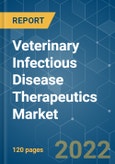Microorganisms are tiny living creatures that are present everywhere, such as bacteria and viruses. Few of the thousands of species of microorganisms invade, multiply, and cause illness in animals and people. Most of the microorganisms live on the skin, in the mouth, upper airways and intestines without causing any harmful disease but some of the microorganism lives in or on a pet, or invades and causes disease depends on the nature of the microorganism and the state of the pet’s natural defenses.
According to World Small Animal Veterinary Association (WSAVA), estimates that 60% to 80% of emerging diseases are zoonotic which indicates the importance of veterinarians in the identification, prevention, and control of infectious diseases. For Example, Rift Valley Fever is an endemic zoonotic disease in Africa and the Middle East that costs producers USD 427 million every year. Increasing prevalence of infectious disease and increasing demand for dairy, meat, and poultry products due to the increasing population size are the key driving factors in the veterinary infectious disease therapeutics market.
Key Market Trends
Antibiotics Segment is Expected to Hold a Major Market Share in the Veterinary Infectious Disease Therapeutics Market
Antibiotic drugs are generally used in veterinary medicine to treat infectious diseases that are caused by bacteria and other microorganisms. Different classes of antibiotics are available for the treatment of infectious diseases in animals, including penicillins, cephalosporins, cephamycins, aminoglycosides, etc. Zoonotic diseases are infectious diseases caused by infections, organisms, and parasites that spread between animals and humans. According to the Centers for Disease Control and Prevention, in the year 2017, found that 24,484 foodborne illnesses, 5,677 hospitalizations, and 122 deaths are caused due to zoonotic diseases.
Hence, owing to the rising number of zoonotic diseases, along with rising pet ownership and increasing research and development (R&D) activities in the veterinary therapeutics are expected to drive the market growth.
North America is Expected to Hold a Significant Share in the Market and Expected to do Same in the Forecast Period
North America expected to hold a major market share in the global veterinary infectious disease therapeutics market due to the rising prevalence of veterinary infectious disease, rising companion animal healthcare expenditure in this region. As per the American Heartworm Society, the number of dogs diagnosed with heartworm per clinic has risen by 21 percent in the United States and its territories between 2013 and 2016. Moreover, increasing the adoption of veterinary products and advancements in veterinary infectious disease therapeutics technology is fueling the growth of the overall regional market to a large extent.
Competitive Landscape
The veterinary infectious disease therapeutics market is moderately competitive and consists of several major players. In terms of market share, few of the major players are currently dominating the market. Some of the major market players are Elanco, Merck & Co. Inc, Boehringer Ingelheim Vetmedica, Zoetis, Dechra Pharmaceuticals PLC, Ceva Sante, Virbac S.A, Bayer AG, Vetoquinol S.A, IDEXX Laboratories, Inc.
Additional Benefits:
- The market estimate (ME) sheet in Excel format
- 3 months of analyst support
This product will be delivered within 2 business days.
Table of Contents
Companies Mentioned (Partial List)
A selection of companies mentioned in this report includes, but is not limited to:
- Elanco
- Merck & Co. Inc
- Boehringer Ingelheim Vetmedica, Inc.
- Zoetis Inc.
- Dechra Pharmaceuticals PLC
- Ceva Santé Animale
- Virbac S.A
- Bayer AG
- Vetoquinol S.A
- IDEXX Laboratories, Inc.








